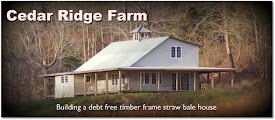Spreading more compost
It didn’t rain last night (there was a chance). So, this morning, I spread compost on the small field near the orchard, at the end of which I planted the 50 asparagus crowns earlier. My compost spreading process involves two tractors, 
This is the field before I started. I disked it a few days ago. Last year, we tried to grow corn here, but the crows and other varmints interfered with that. The soil doesn’t have a lot of humus, appearing to be mostly clay. Like much of the other ground on our farm, it was used to grow tobacco in the past. There were tobacco stalks in it when we moved here almost eight years ago.
I took compost from the piles at then end of the field. Yesterday, 
The manure spreader that I have is an old one that I bought last spring. Of course, it’s not as old as the one I used before I got this one. I’ve only been able to use this one the last couple of days even though I bought it a year ago. Thankfully, it worked fine today. I pulled and powered it with my 1966 International 424. 
Part way through the process, I took a photo of my progress. I’d already spread 10 loads at this time, and the first pile was completely removed and I had started on the second pile. I loaded the spreader with the loader tractor. 
In all, I spread 13 loads on the field. I estimate each load at around 3,000 pounds. Since the spreader is PTO powered, I ran the tractor in first gear to allow the compost to be spread as thickly as possible. I also went over the same ground at least twice. It’s amazing how little it looks like when it is no longer piled up.
Once I finished spreading, it was time to rip the compost into the soil. I didn’t want to leave it on the surface to dry out and lose some of its goodness. 
The field cultivator I used has seven shanks and does a really nice job. This ground was a little harder than the garden I worked yesterday. So, I couldn’t get it to go in quite as deep. Almost as deep though.
It started to rain a little just as I finished working the compost into the ground. I considered that a blessing. It wasn’t much rain, but it was nice to have a little to wet the compost into the ground a bit.
The final photo is of the field after I finished. The soil doesn’t look much darker than before in the photo, but it is a little. It will take several years of working in compost to get it where I would like it to be.
We’ll use this field as a second garden area. I don’t know that we’ll use all of it this year. What we don’t, I hope to sow buckwheat or some other beneficial cover crop on.












